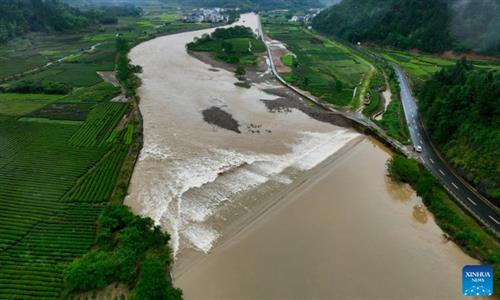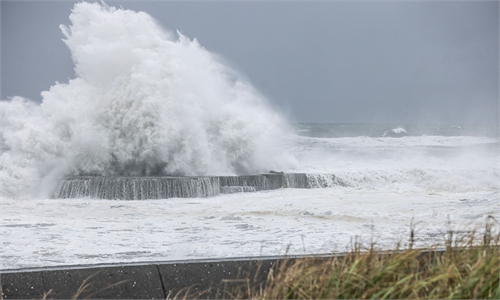China issues yellow alert for rainstorms in multiple regions; expert says rising extreme weather linked to global warming

Post-disaster relief is underway in Rongjiang County, Southwest China's Guizhou Province on June 29, 2025. After being struck by two rounds of heavy flooding within a week which prompted the evacuation of some 90,000 residents and led to six deaths, the flood-stricken riverside county announced on Sunday the end of the heavy rainfall process and terminated the highest-level emergency flood response. Photo: VCG
Following the catastrophic floods in Rongjiang county, Southwest China's Guizhou Province, China's national observatory on Sunday issued a yellow alert for torrential rains in multiple regions, upgrading the emergency response for severe meteorological disasters from Level IV to Level III. Authorities urged affected cities to remain vigilant against mountain floods and geological hazards. Noting that the escalating frequency of extreme weather is linked to global warming, an expert called for relevant departments to enhance capabilities in monitoring, forecasting, and early warning of extreme weather events.
Heavy rains and rainstorms were forecast to hit parts of the provincial-level regions of Southwest China's Sichuan Province, Northwest China's Gansu Province, Northwest China's Shaanxi Province, Southwest China's Chongqing Municipality, Central China's Hubei Province, East China's Zhejiang, Fujian, Anhui, Jiangsu and Shandong provinces, North China's Hebei Province and Northeast China's Liaoning Province from 8 am Sunday to 8 am Monday, the National Meteorological Center said.
Parts of the Sichuan Basin were expected to experience torrential rains, with precipitation up to 300 millimeters, the center added.
The center advised local authorities to take precautions against heavy rainstorms, and suggested that necessary drainage measures should be taken in urban areas and across farmlands.
That same day, the China Meteorological Administration upgraded its emergency response for heavy rainfall from Level IV to Level III.
The administration emphasized the need to be vigilant about the risks of secondary disasters such as mountain floods, geological disasters, and floods along small and medium rivers.
The frequency and intensity of extreme weather events have escalated significantly, primarily attributable to global warming, Ma Jun, director of the Beijing-based Institute of Public and Environmental Affairs, told the Global Times on Sunday.
Recent years have seen extreme weather in China exhibiting a trend of increasing frequency, broader regional impact, greater intensity, and a surge in sudden unheralded events, Ma said.
At 6 pm on Saturday, the National Meteorological Center issued a meteorological risk warning for floods along small and medium-sized rivers in southeastern area of Guizhou Province, noting that the risk of flooding in certain areas was extremely high, CNR reported.
The Ministry of Natural Resources and the CMA jointly issued a meteorological risk warning for geological disasters at 6 pm on Saturday. The orange level alert projected a high meteorological risk of geological disasters in localized areas of southeastern area of Guizhou.
At 5 pm on Saturday, the Sichuan Provincial Department of Water Resources and the Sichuan Provincial Meteorological Bureau jointly issued a blue alert for mountain flood disasters, stating that 29 counties, cities and districts were potentially susceptible to mountain floods from 8 pm Saturday to 8 pm Sunday.
Since Tuesday, Rongjiang county has been hit by catastrophic floods. On Saturday afternoon, floodwaters once again surged into the Rongjiang River, with aerial footage showing widespread inundation in urban areas. More than 40,000 residents had been evacuated as of 6 pm Saturday, China National Emergency Broadcasting reported Sunday.
According to the flood control headquarter of Rongjiang county, as of 11 am on Thursday, the ongoing flood disaster had tragically claimed the lives of six people, the Xinhua News Agency reported.
To address these increasing extreme weather events, relevant authorities are urged to enhance their scientific and technological capabilities for monitoring and forecasting extreme weather, while strengthening capacities in issuing early warning information and the emergency release of major meteorological disaster warnings, Ma said.
For weather forecasting and prediction, emerging artificial intelligence technologies can be leveraged to establish advanced operational frameworks for intelligent perception, forecasting and service delivery, he added.
Mitigating carbon dioxide emissions remains a critical aspect from an individual and social perspective, the expert said.



